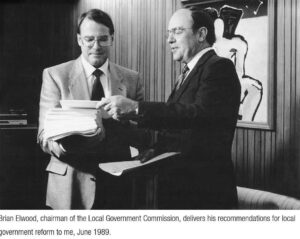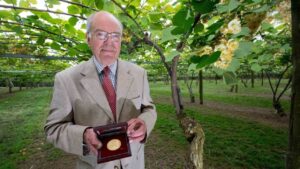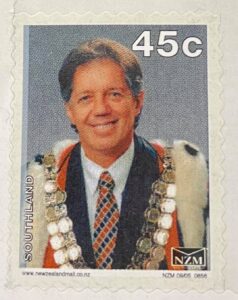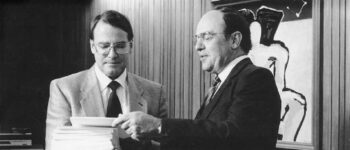1989: The Great Amalgamation
June 20, 2022
By AHNZ
 The Local Government Comission (LGC) was formed in 1946 with the agenda of breaking up community government and handing it over to the Executive. The LGC had tried and failed six times over the years. Then came Labour 4.0.
The Local Government Comission (LGC) was formed in 1946 with the agenda of breaking up community government and handing it over to the Executive. The LGC had tried and failed six times over the years. Then came Labour 4.0.
Local Government Minister Michael Bassett teamed up with Brian Elwood and steamrolled various districts, boroughs, and towns flat. From the resulting pastry the power brokers cut new shapes. Nobody has disenfranchised so many New Zealanders on such a scale since the provinces were abolished in 1876.
Elwood was made totally responsible with Labour 4.0 bound to implement his recommendations. This took the political heat away from Bassett because he could tell the public it was out of his hands. After ‘the great cull’ Elwood was set for life. He was soon knighted and otherwise given State honors and his pick of other plumb government assignments to the rest of his days.
“I was the Minister of Local Government who pushed through amalgamations in 1989, reducing 817 local authorities, boards and special purpose entities to 86. It had taken 113 years to reach that point, and there’d been endless consultation. In the final stages I ensured there was plenty of printed detail on what was proposed, and I did my level best to involve councils, bureaucrats and constituents in the reform process. But I kept well clear of day-to-day decisions on the new entities, believing they should emerge from discussions and negotiations between all the affected local authorities and the Local Government Commission which was led by the able, highly-respected Sir Brian Elwood.” – Michael Bassett, bassettbrashandhide.com (2021)
“Once the bill had been passed, the Governor-General needed to sign it,… Knowing that the law firm Brandon Brookfield was acting on behalf of several bitter opponents of local government reform and was intent on seeking an injunction to stop the schemes being signed at an Executive Council meeting, I ensured that no appointment for this event was entered in my diary…Lange endorsed my suggested procedure, and we arranged for a special meeting of the Executive Council for 9 a.m. on Friday 9 June 1989. Sir Paul Reeves allowed a video camera to record it.” Fourteen orders-in-council were duly signed before Palmer, Caygill, Marshall, Clark, Cullen and me, with John Hill acting on behalf of the Cabinet Secretary. It was all over inside ten minutes.” – Working With David, Bassett (2008)
“1986 to 1989 was a traumatic period for all New Zealand local authorities and nowhere more so than in Mount Maunganui. The Government’s long standing plans for the elimination of some of the country’s most effective and efficient communities manifested itself in sweeping powers granted to the Local Government Commission under the chairmanship of Mr Brian Elwood.”
“Local Government Commission invited all Councils in New Zealand to make submissions on how they saw the future of their districts. There is little or no evidence that the opinions of any Council was given serious consideration or carried any weight with the Commission. It seems that virtually all were disregarded.” – The history of Mount Maunganui, Bruce Cunningham (1989)
“It was a task that six other versions of the commission had failed to complete. Elwood agreed to take on the challenge on the proviso that he had the Government’s absolute backing, and that his determinations would become binding in law, unable to be challenged or appealed.” – Sir Brian Elwood retires from politics and public service, Stuff
“The Tiebout Hypothesis asserts that, when it is efficient to have multiple jurisdictions providing local public goods, then competition between jurisdictions for residents will lead to a near-optimal outcome.” – Wooders (1999,) National Center for Biotechnology Information (USA)
Bassett, an historian, now writes a pro-freedom (go figure) blog with fellow Tiebout Competition denier, and Auckland Supercity Amalgamator, Rodney Hide. The House of Representatives has gradually taken over more and more of New Zealand and is nearly all powerful. This was one of their biggest power plays which is probably why it is seldom explored in government history books.
Boomers to Blame
 On 1 November, 1989, 817 Local Governments were cut down by Labour 4.0 into just 86. Larger regional councils ate up the old counties and boroughs and even some city councils. Big War Lords took over the little ones.
On 1 November, 1989, 817 Local Governments were cut down by Labour 4.0 into just 86. Larger regional councils ate up the old counties and boroughs and even some city councils. Big War Lords took over the little ones.
It was one of the most destructive strides forward of Statism in New Zealand and it was made possible because it happened on Generation Boomer’s watch. They didn’t care for local community as their ancestors had. Big supermarkets, big media, big banks…why not make government big too? To the horror of the aging older generations of New Zealander the Boomers had no scruples about cutting the old basis for local government adrift. Boomers had little or no sensitivity for keeping local power in local hands. They had not inherited the loyalty to their province, their borough, their town, their home territory. Even the Maori Boomers cared little for learning their language or the concept of mana whenua.
And how’s that working out for Local Government in New Zealand since Bassett and Elwood’s stealthy, fully legal, coup?
Here’s how Wellington City Council is spending your money:
Sex worker exhibitions
‘Dismantling e-waste for fun’
Pictionary
Queer and trans drawing classes
Interpretive dance
Music courses for womxn and femmes
A ballet called ‘The S***cracker’
A literal clown show
“Mr Shadbolt recalls thinking that “the big cull of 1989” was a good thing. He’s not so sure now…The significant revolution in 1989, he says, was the shift of power to the bureaucrats. “Mayors soon discovered that CEOs hired and fired staff rather than the mayor and councillors and that the tenders process was also run by senior management … The mayors became little more than show ponies … ” – Rudman (2007,) NZ Herald
“Once the CEO’s controlled the staff and the purse strings, the mayors became little more than show ponies; ribbon cutters; figureheads and promoters for their regions. The Higher Salaries Commission recognises the variation in power and pays mayors less than half of what the CEOs earn.” – Shadbolt (2017,) NZ Herald
“It’s weird because I always thought the whole point of a mayor was not…like they don’t really have any power. Certainly no more power than any other person on the council individually, but they are supposed to be a figurehead. I thought that’s what they were supposed to be. So, ie., Bob Parker and his Parker at the earthquake. He’s not really doing anything, or he’s just saying the right things and making people feel better about things.
“It’s like the mall santas. They’re not the ones actually bringing the presents on Christmas Eve, but they make you feel like there are going to be presents. Isn’t that what a mayor is supposed…anyway,..” – Glenn Hart, Newstalk ZB (30/1/2023)
 Elwood, once mayor of Palmerston North himself, had defected to the Dark Side of Central Government against Local Government well and truly. As he makes clear in his speeches, Sir Brian explicitly sought to turn local government into a plethora of distracting popular fads and inexplicitly to hand power over to Central Government in Wellington. Ref. 1989: Brian’s Revolution, AHNZ
Elwood, once mayor of Palmerston North himself, had defected to the Dark Side of Central Government against Local Government well and truly. As he makes clear in his speeches, Sir Brian explicitly sought to turn local government into a plethora of distracting popular fads and inexplicitly to hand power over to Central Government in Wellington. Ref. 1989: Brian’s Revolution, AHNZ
Brian (Silent Generation himself,) handed the Baby Boomers a very different New Zealand. Hitherto, government had confined itself to economic and social realities, he said. Now the containment interface for the tax livestock would need to also provide the feelings of ‘worth and recognition’ that the Boomer craved. Devoid of an inner source (perhaps due to upbringing, Ref. 1944: No serotonin for you, Boomer!, AHNZ) the Boomer was open to The State providing an external source of self-esteem. This was Elwood’s hack to wedge open and exploit to grow the size of government.
The country we have had since Elwood’s “revolution” and “reform” has relegated our elected officials to ribbon-cutters and figureheads. Wellington and permanent un-elected bureaucrats call the shots for your local home territory now. Politics has become showbusiness for ugly people. An honorary role of providing publicity and taking blame similar to what has happened to the Governor while real power has concentrated on Cabinent and in particular the Prime Minister’s Office.
Elwood’s reform has turned local government and civic responsibility into distracting side-show to divert voters from what’s really happening to their home. They don’t even know they have a home territory to love and protect because this depends on values the Boomer did not pass on to the following generations. Central Government has outsourced the difficult job of keeping people in line to the “showpony” and “ribbon-cutter” elected officials and left themselves (and the United Nations) free to rule.
Elwoodian Democracy
The Shape-shifting local government becomes whatever fashionable Current Thing it needs to transmute into to pacify the local population that has replaced the local community. Hence, we now have activist councils that spend your money on things like sex worker exhibitions, queer and trans drawing classes, and ballets called ‘The S***cracker’. All such faddish promotions have become the legitimate core business of local government because of Brian Elwood’s Great Amalgamation of 1989.
It will take an equal and opposite revolution to again close the door that Sir Brian opened but only if our country is strong enough to survive long enough to have such a restructuring. While New Zealanders suffer from amnesia as to their national identity and the drug of Elwoodian Democracy keeps us anesthetised were a at risk. Our undefended and undervalued country could easily be taken over by cultures and ethnicities who are under no such doubt as to who they are and who New Zealand belongs to.
—
Image ref. Onehunga Borough Council’s epitaph, AHNZ Archives
Image ref. Bassett and Elwood, Working With David, Bassett (2008)
Image ref. Publicity photo, Sir Brian Elwood retires from politics and public service; Fairfax NZ, Manawatu Standard, Stuff (2015)
Update 2023: Added Glenn Hart’s metaphore. Not bad.
3 thoughts on "1989: The Great Amalgamation"
Leave a Reply
 Like Comment Share
Like Comment Share






Thank you, this explains an aspect of local government that has always troubled me. I also reinforces that my view not to vote for ex central government politicians at the local government level.
They know where the money is.
What aspect is that? The bread and circuses?